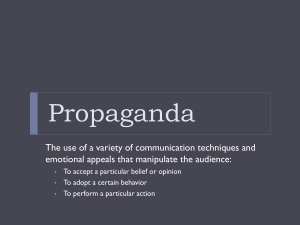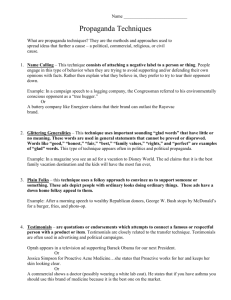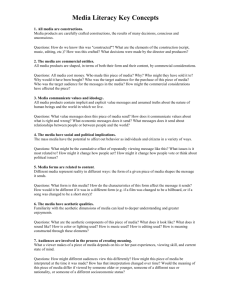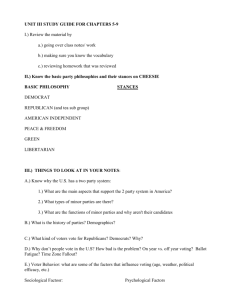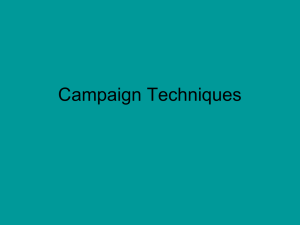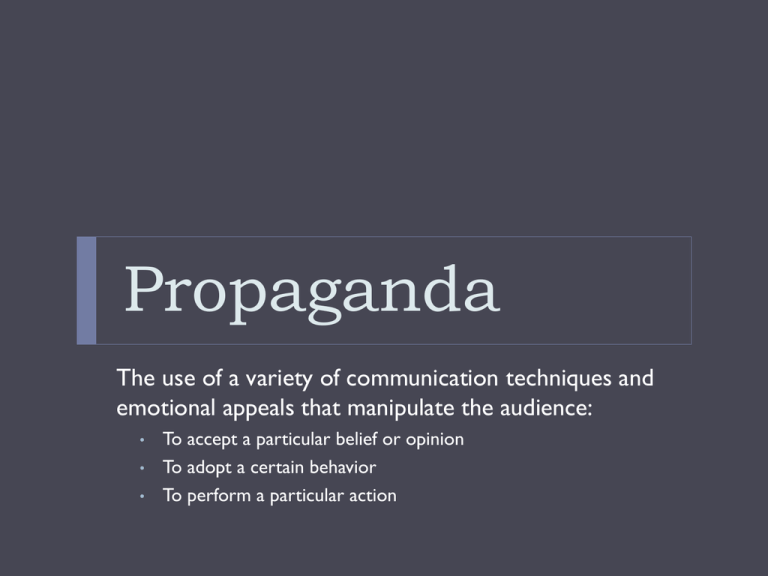
Propaganda
The use of a variety of communication techniques and
emotional appeals that manipulate the audience:
•
•
•
To accept a particular belief or opinion
To adopt a certain behavior
To perform a particular action
In a culture where we are bombarded
with other people, images, and
influences trying to define us, how do
we make decisions for ourselves?
Historical Propaganda
The great masses of
the people will
more easily fall
victim to a big lie
than to a small one.
– Adolf Hitler
Mein Kampf
Victory or Bolshevism
Fundamentals
Propaganda is information, ideas, or rumors deliberately
spread widely to help or harm a person, group, movement,
institution, nation, etc.
Bias is a personal and often unreasoned judgment for or
against one side or perspective in a dispute.
Assertion is an enthusiastic or energetic statement
presented as a fact, although it is not necessarily true.
They often imply that the statement requires no
explanation or back up, but that it should merely be
accepted without question. Assertions are commonly used
in advertising and propaganda.
Examining Nine Types
of Propaganda
in Advertising
Bandwagon
The idea that everybody else
is doing it, or everyone
supports this person or
cause, so you should too.
Bandwagon plays off the
human desire to be
accepted.
Example: Coca-Cola Ads portray
young people having fun at a party
Bandwagon
Key words to watch:
Everyone
Ours
Yours
We
Us
Don’t miss out!
Sweeping the Nation
Call or Act Now!
What are you waiting for?
Join the sensation!
Testimonial
The celebrity
endorsement of a
philosophy, movement,
candidate, or product.
Example: Tiger Woods,
Roger Federer, and
Thierry Henry for
Gillette razors
Transfer
The use of words or
symbols that will transfer
your feelings about one
image to the product being
sold.
Types of Transfer
Patriotism
Sex Appeal
Love or Popularity
Power and Fame
Money and Wealth
No Product Connection in Transfer
Often, there are no clear
representational connections
in contemporary advertising.
One of the common traits of
print advertising is of the
naked or sexually-posed
woman selling a product.
Transfer of Sex Appeal in The Gaze
The power of men
over women is
exhibited in many
senses. Men have
more power because
of social status, which
allows them to harass
women.
Visual harassment
means that men have
the power of the gaze
– they can watch
women in private and
in public.
Repetition
The product name or slogan is repeated several times
within the advertisement.
Example: Target ads display the Target symbol numerous times
Emotional Words
Words used to make
you feel strongly about
someone or something
Example: Use of the
word “Romance” in
Ralph Lauren perfume
and cologne ads
Glittering Generalities
Uses appealing words and
images to sell the product;
Generally accepted virtues
are used to stir up favorable
emotions.
Words such as democracy,
family values, rights, or
American are used in a
positive sense.
If you buy this item, you will
be using a wonderful product,
and it will change your life.
Example: Blue Bell ice cream’s slogan, “Blue Bell
homemade ice cream tastes just like the good old days!”
Name-Calling
Ties a person or
cause to a largely
perceived negative
image.
Example: Anti-Bush
ad commenting on
his intelligence
level.
Fear
Presenting a dreaded circumstance of a choice or action.
Example: NotEvenOnce.com ad promoted by the Montana Meth Project.
A recent study notes that this ad campaign has reduced teen Meth use in
Montana by 45%. This ads’ effectiveness has prompted the Federal
Government to run the ad in other states.
Plain Folks
The candidate or cause is identified with common people from
everyday walks of life.
Example: Dove ads using real women to show sell their firming
cream
Your Turn!
Your Turn!
Your Turn!

